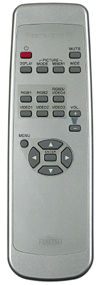Fujitsu Plasmavision SlimScreen P50XHA10U high-definition plasma display Page 2
 But the P50XHA10U looked so good in other respects that you'll risk being $11k lighter in the wallet by just looking at it in a store. It was amazingly sharp and detailed, but never to an artificial degree. I've never seen a CRT rear-projection set of anywhere near this size look this crisp. Video noise–a problem with some earlier plasmas–was not a factor. Apart from those bright greens, the colors were vivid yet natural, and flesh tones–after a good calibration–were as good as I've ever seen from a video display. Viewed side by side with a properly calibrated Hitachi CRT of the same size, the P50's image did show a subtle green shift, but this was almost never evident when I watched the Fujitsu on its own.
But the P50XHA10U looked so good in other respects that you'll risk being $11k lighter in the wallet by just looking at it in a store. It was amazingly sharp and detailed, but never to an artificial degree. I've never seen a CRT rear-projection set of anywhere near this size look this crisp. Video noise–a problem with some earlier plasmas–was not a factor. Apart from those bright greens, the colors were vivid yet natural, and flesh tones–after a good calibration–were as good as I've ever seen from a video display. Viewed side by side with a properly calibrated Hitachi CRT of the same size, the P50's image did show a subtle green shift, but this was almost never evident when I watched the Fujitsu on its own.
The strengths of the P50 were never more evident than on high-definition images. I found myself watching movie after movie on HBO and Showtime HD. The display was so compelling that I even watched such sterling fare as Ace Ventura, Pet Detective; Dr. Doolittle II; Buffy the Vampire Slayer; and Evolution. I drew the line at Queen of the Damned. (Please, HBO/Showtime: I love your HD service, but let's get more A movies in addition to the occasional Shrek and A Beautiful Mind!) And the remake of Gentle Ben on Discovery HD Theater also looked great, even with all that mountain greenery. Discovery HD puts out a consistently great picture and impressive sound, but one can watch only so many documentaries about Canadian rivers (a lot of Canadian rivers). Programming limitations aside, the images produced on the P50 with this hi-def material almost defied adequate description. It was impossible to do anything else while watching. The P50 simply commanded that I dim the lights and watch. Resistance was futile.
The Fujitsu's performance was nearly as good with first-rate DVDs. All of my current reference discs–The Lord of the Rings: The Fellowship of the Ring, Star Wars Episode II: Attack of the Clones, High Fidelity, Charlotte Gray, Monsters, Inc.–looked as good as I've ever seen them, except for the occasional very dark, low-contrast scene.
I did most of my serious viewing with component (Y-Pr-Pb) sources. With more conventional sources, such as cable or even (as noted earlier) a standard-definition program recorded on tape or PVR with a composite or S-video feed, the images were less amazing. You can't eliminate the problems from a poor source, and a high-resolution display such as the P50 will simply display what you feed it, warts and all. But you don't buy a set like this to view nothing but shows recorded at the slowest speed on a PVR. I found the picture on such material watchable, particularly with the noise filter turned up a bit, but this by itself wouldn't justify the set's price. However, even apart from that sexy, hang-on-the-wall thing, the P50 made an irresistible case for itself with hi-def and DVD sources.
While I was unable to try a high-definition DVI source with the P50, I did briefly try DVD through a DVI connection, courtesy of Faroudja's Digital Cinema Source, a combined player-scaler configured to operate at the 768p native rate of the P50. It worked superbly–though it required significantly different Brightness and Contrast settings than the component feed. It will take a lot more watching of this and other equipment before we can judge whether or not DVI offers significant performance advantages. It looked great here–but then, so did a component connection from far less ambitious and expensive players.
Fujitsu's AVM processor-scaler was every bit as effective in the P50XHA10U as it had been in the PDS-5002. Apart from occasional twittering on such fine horizontal details as venetian blinds (a problem with most displays), I was never distracted by scaling artifacts. The scaler's 24-frame film mode worked as advertised, properly dealing with the 3:2 pulldown inherent in film-to-video transfers. There was no Auto setting to automatically engage the Film mode when it detects the "film" flag in properly coded material, but I left Film mode on all the time and never detected a problem.
It's the Same Old Story
When I reviewed the Fujitsu PDS-5002, I said: "If I had the cash and was looking for the best 50-inch picture I could find, the Fujitsu Plasmavision PDS-5002 is the one I'd buy." I'd say the same about the Fujitsu Plasmavision SlimScreen P50XHA10U. You'll get better blacks from a CRT. And for roughly the same price, you can get a big, immersive, nearly as crisp image from one of the new DLP projectors with a 16:9 HD2 chip. But if you want a one-piece display that will produce a vivid, compelling picture in everything from average room lighting to full darkness while taking up virtually no space, and that's big enough for a real home-theater experience, you're unlikely to do better than this one.













































